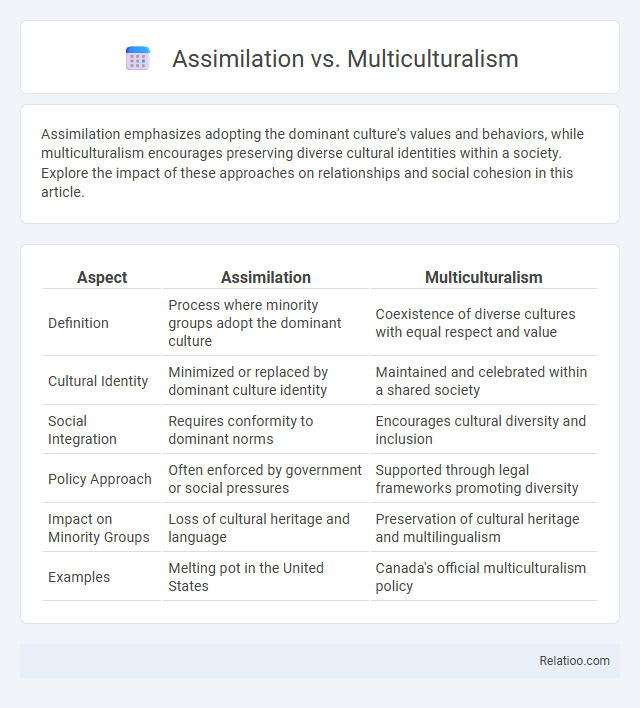Assimilation emphasizes adopting the dominant culture's values and behaviors, while multiculturalism encourages preserving diverse cultural identities within a society. Explore the impact of these approaches on relationships and social cohesion in this article.
Table of Comparison
| Aspect | Assimilation | Multiculturalism |
|---|---|---|
| Definition | Process where minority groups adopt the dominant culture | Coexistence of diverse cultures with equal respect and value |
| Cultural Identity | Minimized or replaced by dominant culture identity | Maintained and celebrated within a shared society |
| Social Integration | Requires conformity to dominant norms | Encourages cultural diversity and inclusion |
| Policy Approach | Often enforced by government or social pressures | Supported through legal frameworks promoting diversity |
| Impact on Minority Groups | Loss of cultural heritage and language | Preservation of cultural heritage and multilingualism |
| Examples | Melting pot in the United States | Canada's official multiculturalism policy |
Introduction to Assimilation and Multiculturalism
Assimilation involves integrating individuals into a dominant culture by encouraging conformity to its norms and values, often leading to the loss of original cultural identity. Multiculturalism, in contrast, promotes the coexistence of diverse cultures within a society, valuing and preserving differences while fostering mutual respect and inclusion. Your understanding of these concepts helps navigate social dynamics and supports informed discussions on cultural integration policies.
Defining Assimilation: Key Concepts
Assimilation involves the process by which individuals or groups adopt the cultural traits, values, and behaviors of a dominant society, often leading to a loss of original cultural identity. Key concepts include cultural absorption, social integration, and the expectation that minority groups conform to mainstream norms. You should understand that assimilation contrasts with multiculturalism, where diverse cultures coexist without the pressure to conform.
Multiculturalism Explained: Core Principles
Multiculturalism emphasizes the coexistence of diverse cultural identities within a society while promoting mutual respect and equality among all groups. It prioritizes the preservation of cultural heritage and encourages intercultural dialogue to foster social cohesion without requiring individuals to abandon their original cultures. Core principles include inclusivity, cultural pluralism, and the recognition of diversity as a strength that enriches the social fabric.
Historical Perspectives on Cultural Integration
Historical perspectives on cultural integration reveal distinct approaches: assimilation emphasizes the absorption of minority groups into the dominant culture, often leading to loss of original identities, while multiculturalism advocates for the preservation and coexistence of diverse cultures within a society. Segregation, in contrast, enforces the separation of groups, limiting interaction and often maintaining social inequalities. These models reflect varying societal values and policies shaped by historical contexts, such as immigration patterns, colonialism, and civil rights movements.
Advantages of Assimilation Policies
Assimilation policies promote social cohesion by encouraging individuals to adopt common cultural norms, enhancing national unity and reducing cultural conflicts. Your integration into society becomes smoother as these policies foster a shared identity and facilitate communication within a unified framework. Advantages include streamlined governance, improved social stability, and increased opportunities for economic participation.
Benefits of Multicultural Approaches
Multicultural approaches promote social cohesion by valuing diverse cultural identities, enhancing mutual respect and reducing xenophobia. Your community gains enriched cultural experiences, innovation, and broader perspectives through inclusive policies that embrace diversity rather than enforcing uniformity. Emphasizing multiculturalism supports equal opportunity and psychological well-being by allowing individuals to maintain their heritage while participating fully in society.
Challenges and Criticisms of Assimilation
Assimilation faces challenges such as the loss of cultural identity and social alienation among minority groups, often leading to resistance and psychological stress. Critics argue it promotes cultural homogenization, undermining diversity and marginalizing non-dominant cultures in societal integration processes. In contrast, multiculturalism supports cultural pluralism but can encounter difficulties in fostering social cohesion and equal representation, while integration seeks a balanced approach between these models.
Controversies Surrounding Multiculturalism
Multiculturalism faces controversies surrounding social cohesion and integration, with critics arguing it may foster division rather than unity within diverse societies. Opponents claim that excessive emphasis on cultural differences undermines national identity, leading to fragmented communities and weakening the common social fabric. Understanding these debates helps you evaluate the complexities of multicultural policies compared to assimilation approaches.
Assimilation vs Multiculturalism in Modern Societies
Assimilation in modern societies emphasizes the absorption of minority groups into the dominant culture, promoting uniformity in language, values, and social norms, while multiculturalism advocates for the coexistence and celebration of diverse cultural identities within a single society. Assimilation often leads to the loss of minority cultural distinctiveness, whereas multiculturalism supports cultural pluralism and encourages equal respect for multiple traditions, fostering social inclusion and diversity. The debate between assimilation and multiculturalism reflects differing approaches to integration policies, immigrant identity preservation, and social cohesion in contemporary urban contexts.
Future Trends: Balancing Assimilation and Multiculturalism
Future trends indicate an increasing push towards balancing assimilation and multiculturalism to foster social cohesion without erasing cultural identities. Policymakers are exploring integrative models that promote mutual respect and inclusion, allowing individuals to maintain distinct cultural practices while participating fully in the broader society. Advances in digital communication and global migration patterns further support hybrid identities, emphasizing the need for adaptive strategies that accommodate changing demographics and evolving cultural dynamics.

Infographic: Assimilation vs Multiculturalism
 relatioo.com
relatioo.com